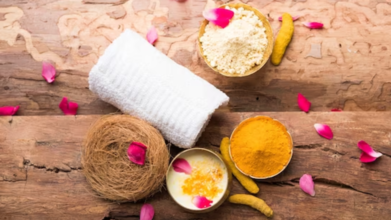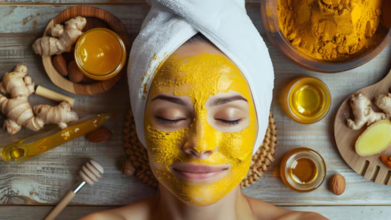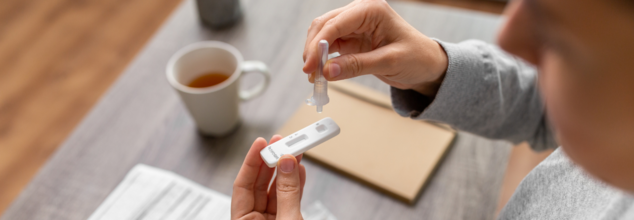- Health Conditions A-Z
- Health & Wellness
- Nutrition
- Fitness
- Health News
- Ayurveda
- Videos
- Medicine A-Z
- Parenting
- Web Stories
7 Homemade Besan Packs for Glowing Skin

Homemade besan packs (Credit-Freepik)
Besan is no longer just a super ingredient in the kitchen for great food recipes but is also one of the most widely used items for skincare packs. Not only is it safe to use on the skin daily, but it is also known to fix sunburn and reduce the appearance of dark spots on the skin. However, if you have dry skin, try not using it as much as it has a drying effect on the skin. If you want to test it, take a patch test on your skin.
Benefits of besan packs
It is known to improve skin health and lighten your skin tone without any chemicals. It exfoliates and reveals fresher and healthier skin. It also helps in removing dead skin and improving skin texture.
1. Classic besan and yoghurt pack
This age-old combination is a boon for oily skin. The gentle exfoliation of besan combined with the lactic acid in yoghurt helps regulate sebum production, unclog pores, and reduce acne breakouts. The cooling effect of yoghurt also soothes inflamed skin.
2. Besan and turmeric pack
A powerful duo for a radiant complexion, besan and turmeric work synergistically to brighten the skin. Turmeric's anti-inflammatory properties help calm redness and reduce blemishes, while besan gently exfoliates and removes dead skin cells.
3. Besan and honey pack
This hydrating pack is a blessing for dry skin. Honey's humectant properties draw moisture into the skin, while besan gently cleanses and refines the skin's texture. Regular use leaves the skin soft, supple, and nourished.

4. Besan and lemon pack
A potent combination for oily and acne-prone skin, this pack helps to control excess sebum, lighten blemishes, and promote a brighter complexion. Lemon's natural bleaching properties help fade acne scars over time.
5. Besan and sandalwood pack
Soothing and calming, this pack is ideal for sensitive skin. Sandalwood's anti-inflammatory properties reduce redness and irritation, while besan gently cleanses and refreshes the skin.
6. Besan and oatmeal pack
This gentle exfoliating pack is suitable for all skin types. Oatmeal's fine texture helps remove dead skin cells without causing irritation, while besan deep cleanses the pores and absorbs excess oil.
7. Besan and aloe vera pack
This hydrating and soothing pack is perfect for irritated skin. Aloe vera's cooling and anti-inflammatory properties calm redness and inflammation, while besan gently cleanses and purifies the skin.
What Is Acute Gastroenteritis? The Gastric Issue Real Madrid’s Star Footballer Kylian Mbapp Was Hospitalized For

Football fans around the world were stunned when Real Madrid confirmed that Kylian Mbappé, its French captain and marquee signing, was hospitalized for an acute bout of gastroenteritis during the Club World Cup. Although Real Madrid had originally reported that he was absent for the initial match because of illness, there was a formal medical report that confirmed the extent of his illness and in-hospital treatment and tests he required.
Even though Mbappé is recovering now with specific medical treatment outside the hospital, his sudden health fright focused fresh public attention on a prevalent but poorly understood illness: acute gastroenteritis.
What Gastroenteritis?
Gastroenteritis is the inflammation of the stomach and intestines that causes vomiting, diarrhea, cramps in the abdomen, and occasionally fever or muscle pain. Commonly called the "stomach flu," it is not caused by the flu virus and has nothing to do with respiratory infections. Rather, it is usually caused by infection or chemical irritants to the gastrointestinal (GI) tract. There are two main types:
- Infectious gastroenteritis – due to viruses, bacteria, parasites, or fungi.
- Chemical gastroenteritis – due to ingestion of poisonous substances such as some drugs, alcohol, or polluted food/water.
Mbappé's illness is an acute gastroenteritis, which means the symptoms came on suddenly and intensely but would likely pass with good care.
How Gastroenteritis Spreads?
The most prevalent reason for gastroenteritis is the intake of contaminated food or water. It is also spread by contact with infected people or surfaces they have contacted. Some typical situations include:
- Consumption of undercooked meat or seafood
- Inadequate washing of hands after using the toilet
- Drinking unbottled or unfiltered water during travel
Though most individuals recover quickly, individuals with compromised immune systems—such as young children, elderly, or those with chronic diseases—are at a higher risk for developing complications like dehydration and extended illness.
Symptoms Of Gastroenteritis
Acute gastroenteritis usually presents with a combination of the following:
- Sudden onset of watery diarrhea (non-bloody)
- Nausea and vomiting
- Abdominal cramps or bloating
- Low-grade fever
- General fatigue or muscle aches
These symptoms typically occur within 1–3 days of contact with the infection and can last anywhere from 24 hours up to two weeks, depending upon the cause and the immune response of the patient.
In the Mbappé case, the symptoms were bad enough to need hospitalization, which is not usual but required for observation of dehydration, electrolyte disturbances, or ongoing vomiting.
What Causes Gastroenteritis?
The origin of gastroenteritis comes from the inflammatory reaction in the body from a threat within the gastrointestinal system. Pathogens or toxic chemicals entering the system will have the immune reaction summon inflammation to combat invaders and heal damage.
In a majority of instances, it is an acute and transient condition. But if the infection is especially virulent or if the immune system of the body is weakened, inflammation becomes intense, aggravating symptoms and necessitating medical attention. The most common offenders are:
- Viruses (such as norovirus and rotavirus)
- Bacteria (E. coli, Salmonella, or Campylobacter)
- Parasites (Giardia)
- Fungi (uncommon but potential in immunocompromised hosts)
How Serious Is Acute Gastroenteritis?
For otherwise healthy people, acute gastroenteritis is usually self-limiting and resolves with rest and hydration. For elite athletes such as Mbappé, any alteration in the body's fluid and nutrient balance can have a profound impact on performance and recovery. The disease becomes more severe when:
- Dehydration occurs from heavy vomiting and diarrhea
- The symptoms do not improve after a few days
- There is the presence of blood in stool
- There's a loss of ability to retain fluids
- Fever is severe and persistent
In such instances, hospitalization is advisable—as in Mbappé's case—for rehydration, electrolyte balance, and observation.
What You Can Do to Stay Safe?
Although not all gastroenteritis cases can be avoided, the risk may be drastically cut down by sensible and preventive hygiene practices. Here's how:
1. Practice Proper Handwashing
Hand washing with soap and water for 20 seconds or more, particularly before eating and after using the bathroom, is one of the best means of preventing the transmission of GI infections.
2. Safe Food Handling
Do not cross-contaminate when handling food, thoroughly cook meat, and refrigerate perishables immediately. Wash fruits and vegetables before eating.
3. Safe Water to Drink
While traveling, use sealed bottled water, don't drink ice in beverages, and eat only cooked or packaged food to minimize the risk of "traveler's diarrhea."
4. Clean Surfaces
Disinfect surfaces frequently in shared spaces such as gyms, bathrooms, or kitchens to stop the spread of infection.
5. Watch Out for Medication and Drug Use
Excessive alcohol or certain medications use can irritate the lining of the gut and lead to chemical gastroenteritis.
While Kylian Mbappé will soon return to action, his recent hospitalization is a reminder that even the best professional athletes are not beyond the reach of diseases such as gastroenteritis. It also emphasizes the value of early treatment and medical surveillance in more complicated instances.
For the general public, it is imperative that they know about the causes, symptoms, and prevention of gastroenteritis—particularly with increasing travel and food safety as an ongoing global issue. With the right information and good hygiene techniques, most instances of gastroenteritis can be prevented or treated at home. But learning when to seek assistance—such as Mbappé's medical team—is what can turn the tables.
Acute gastroenteritis is widespread, but its effect can be from mild disruption to severe health risk depending on how it is handled. As a world-class sportsman or an average person coping with day-to-day well-being, early recognition of the symptoms, fluid intake, and attention to food and hygiene safety can keep you one step ahead of this miserable but avoidable illness.
Cancer-Free Woman After Double Mastectomy Gets Diagnosed With Incurable Cancer Decades After Her First Cancer Diagnosis

(Credit-Hudson Valley Times)
Although there is no ‘cure for all’ way to eradicate cancer, treatments and medicine have made survival rates much higher. While more cancer treatments do help people go into remission, which is when the symptoms of a disease like cancer lessen or go away.
However, the chances of cancer coming back are still present, which is a reality many cancer patients have to deal with. For one such survivor, this reality may be permanent. Carol Johnson-Cromer is a powerhouse of energy, resilience, and a deep commitment to helping others. She's a three-time breast cancer survivor, first diagnosed in 2000 at age 38, and again in 2019 and 2023.
Facing Cancer Head-On
Carol's first breast cancer diagnosis came less than a month after a routine check-up when she found a lump. Her doctor quickly arranged a biopsy, which confirmed that it was breast cancer. Carol underwent lumpectomy, chemotherapy, radiation, and took Tamoxifen.
Nearly 20 years later, she found another lump in the same breast. After almost two decades in remission, and with a strong desire to live fully for her family and community, she chose to have a double mastectomy. Carol felt an urgent need to move forward, and her determination helped quiet her fears during this time.
But her fight wasn't over. Four years later, she found another lump, this time on the right side of her neck, and was diagnosed with metastatic breast cancer. Carol has since embraced a "new normal," which includes ongoing, lifelong treatment for cancer.
What is Metastatic Breast Cancer?
According to the National Breast Cancer Foundation, metastatic breast cancer (MBC) means the breast cancer has spread from where it started in the breast to other parts of your body. It's also called Stage 4, advanced, or distant breast cancer.
Cancer cells can spread in a couple of ways: sometimes, the cancer comes back in a different part of the body months or years after you were first treated (this is called a distant recurrence). Other times, the cancer has already spread to other areas by the time it's first found (this is called de novo metastatic breast cancer).
The most common type of breast cancer, called invasive ductal carcinoma (IDC), usually spreads to the bones, lungs, liver, or brain. Another type, called invasive lobular carcinoma (ILC), often goes to organs like the uterus, ovaries, stomach, intestines, and sometimes the brain.
Right now, there isn't a cure for metastatic breast cancer. However, more and more women are living longer with the disease. Doctors focus on managing it like a long-term illness through ongoing treatment and monitoring, with the main goal of keeping your quality of life as good as possible.
Despite the immense challenges, Carol found strength within herself. “The challenge every time is maintaining a positive mindset, focusing on the body by exercising in the midst of exhaustion, and embracing one’s spirit by waking up every day ready to breathe life and light into every person, place, or thing,” she said.
Why Some Cancers Come Back
The Cancer Research UK explains that even after treatment, a few cancer cells might be left behind and start to grow again, forming a new tumor. Sometimes, cancer cells might have already spread to other parts of the body but were too small to be seen. These tiny, hidden groups of cells can then grow into new tumors later on.
Even though surgeons try their very best to remove all cancer during an operation, it's possible that a tiny group of cancer cells gets left behind. Also, some cancer cells might have already broken off from the main tumor before surgery but were too small to be noticed. These are called micrometastases.
If your doctor thinks there's a chance cancer cells were left or had spread, they might suggest more treatment after surgery, called adjuvant treatment. This extra treatment could be chemotherapy, radiotherapy, hormone therapy and targeted cancer drugs.
When Cancer Becomes Resistant to Treatment
Sometimes, cancer cells can become "resistant" to cancer drugs, meaning the drugs stop working. This happens because cancer cells can change or mutate over time. These changes can make them ignore the drugs that used to kill them. If this happens, doctors might try a different type of treatment. Sometimes, cancers can even become resistant to many drugs at once.
Scientists have found that some of these changes can make cancer cells pump the drugs out, keeping them from working. Researchers are constantly looking for ways to overcome this resistance to make treatments more effective.
Many cancers can be cured today. However, some cancers can return many years later, which is why doctors might be careful about using the word "cure." Instead, they often say your cancer is in remission. This means there's no sign of cancer in your body. If any cancer cells are left, they are either too few to find, too few to cause problems, or are simply not active and not growing.
Because doctors can't be 100% sure all cancer cells are gone, they might suggest long-term treatment, like hormone therapy or a targeted drug, to try and stop the cancer from coming back.
Living with Uncertainty
It can be very tough to live with the thought that your cancer might come back. Even if doctors say there's a very high chance your cancer is gone for good, it's natural to feel worried that they can't be absolutely certain.
Some people find it hard to stop thinking about it or feel afraid to plan for the future. While this feeling is common, for most people, the risk of cancer returning goes down over time. Most cancers that do come back usually do so within the first 2 years after treatment. After 5 years, the chance is even lower. For some cancers, after 10 years, your doctor might finally say you're cured. If you are finding it difficult to cope with, reach out for help and look into support groups and mental health support sources.
Do Covid-19 At-Home Tests Detect The New Variants?

(Credit-Canva)
In many ways COVID-19 has changed the way medicine and treatments work. During peak COVID wave, at-home test kits became a more accepted part of medical care for people, as stepping outside and visiting hospitals could also cause infection. As new strains of COVID keep mutating, many people have brought up concerns regarding the effectiveness of the at-home tests.
The concern is regarding the fact that these at-home test kits are equipped to diagnose the new strains or are there certain strains that can go undetected.
How At-Home COVID Tests Work?
If you start feeling sick with symptoms like a cough, fever, or runny nose, you might worry if it's COVID-19. A simple way to check is by using an at-home COVID-19 test. You can easily find these tests at drugstores, supermarkets, and online stores.
At-home COVID-19 tests are designed to find tiny parts of the SARS-CoV-2 virus, which causes COVID-19. These parts are called antigens. Rapid at-home antigen tests usually give you results in about 15 minutes. If your test is positive, it's very likely you have the virus.
It's important to know that these tests can sometimes give a false negative, meaning you could test negative but still have the virus. However, because these tests are quick and rarely give a false positive, they can be very useful if used correctly.
Do They Work Against New COVID Variants?
At-home COVID tests should work against newer versions of the virus, “The antigen, that the at-home tests look for has remained fairly stable even as the virus mutates and new strains of COVID develop”. Harvard Health experts explain that the part of the virus these tests look for stays pretty much the same, even as the virus changes. Research generally shows that these antigen tests are good at finding different COVID-19 variants.
In a comparative study published in the Microbiology Spectrum journals, researchers looked at 2 types of tests PCR test and rapid antigen tests (Ag-RDTs). They used FIA which is the flourescence immunoassay, a simple and rapid technique that is used to measure compounds like drugs, hormones and proteins and LFIA which is lateral flow immunoassay, that is also used to detect proteins, haptens (a type of molecules), nucleic acids etc. Both rapid tests were 100% accurate at finding the virus when there was a lot of virus in the sample. However, their ability to find the virus dropped to around 30% when there was only a small amount of virus present.
This study confirms that rapid antigen tests (especially FIA and LFIA) work almost as well as RT-PCR tests for finding SARS-CoV-2. The FIA test was particularly good for people who had the virus but no symptoms. Both rapid tests agreed strongly with the gold standard RT-PCR results.
When to Test for COVID?
Harvard Health experts advise using an at-home COVID test if you have respiratory symptoms like a cough, fever, or runny nose. She also suggests testing if you've been around someone with COVID-19, or if you're going to be near elderly people or those with weak immune systems who could get very sick from the virus.
In general, these tests are most effective when you have symptoms. One study found that certain at-home tests caught almost 90% of COVID cases in people with symptoms, but only about half of cases in people who had the virus but no symptoms.
If your test is positive, it means you have the virus. If it is negative, health authorities recommend taking another test 48 hours later to reduce the chance of a false negative.
If you have respiratory symptoms, these combination tests are an easy way to find out if you have the flu, COVID-19, or both, without needing to visit a doctor's office. You can also help public health efforts by reporting your test result (whether it's positive or negative) online.
The best way to protect yourself from both COVID-19 and the flu is to get vaccinated for both. Vaccines lower your risk of getting sick and developing serious complications if you do catch the viruses.
© 2024 Bennett, Coleman & Company Limited

